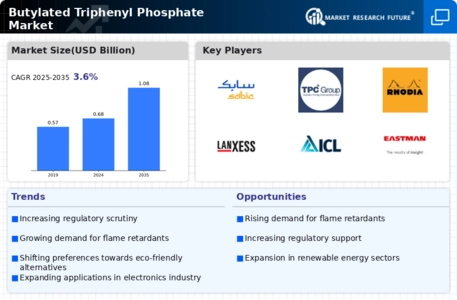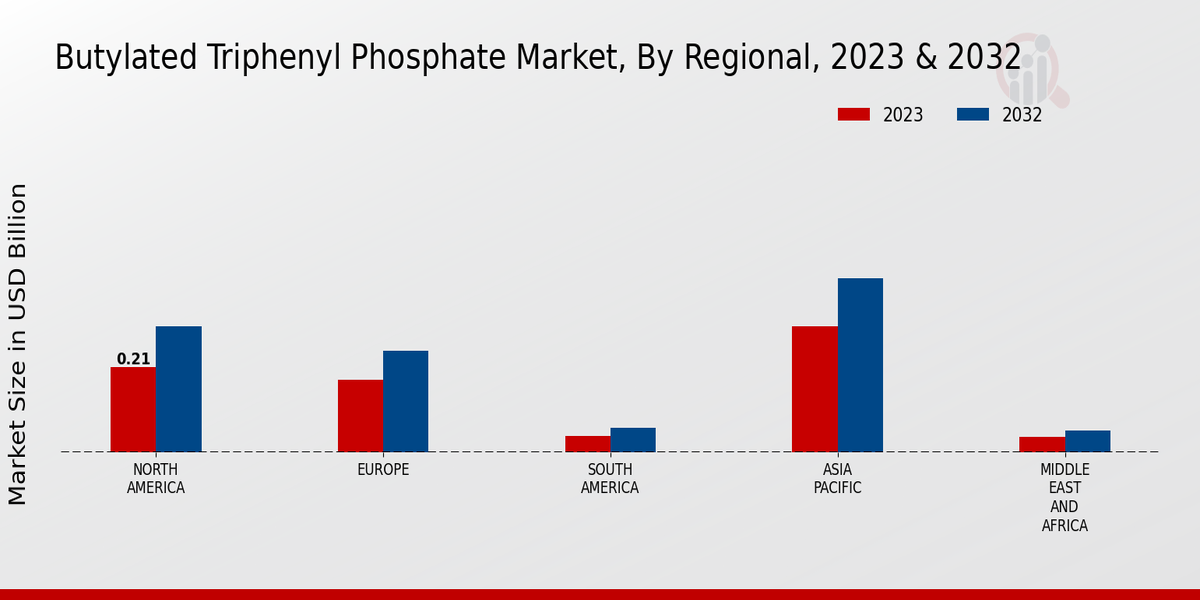Market Growth Projections
The Global Butylated Triphenyl Phosphate Market Industry is projected to experience substantial growth over the next decade. With a current market value of 0.68 USD Billion in 2024, the industry is expected to reach 1.08 USD Billion by 2035. This growth trajectory indicates a compound annual growth rate of 4.28% from 2025 to 2035, reflecting the increasing adoption of butylated triphenyl phosphate across various applications. The market's expansion is driven by factors such as regulatory support, technological advancements, and rising safety awareness, positioning it favorably for future developments.
Growing Demand in Electronics
The Global Butylated Triphenyl Phosphate Market Industry experiences increasing demand from the electronics sector, where it is utilized as a flame retardant and plasticizer. As electronic devices become more prevalent, the need for materials that enhance safety and performance rises. In 2024, the market is valued at approximately 0.68 USD Billion, reflecting the industry's response to this demand. The trend is expected to continue, with projections indicating a market growth to 1.08 USD Billion by 2035. This growth suggests a compound annual growth rate of 4.28% from 2025 to 2035, highlighting the electronics sector's pivotal role in driving the market forward.
Increasing Awareness of Fire Safety
There is a growing awareness of fire safety across various sectors, which is significantly influencing the Global Butylated Triphenyl Phosphate Market Industry. Industries such as construction, textiles, and consumer products are increasingly prioritizing fire-resistant materials to protect lives and property. This heightened awareness is driving the demand for butylated triphenyl phosphate, as it is recognized for its effectiveness as a flame retardant. The market's value is expected to rise from 0.68 USD Billion in 2024 to 1.08 USD Billion by 2035, reflecting a compound annual growth rate of 4.28% from 2025 to 2035. This trend indicates a proactive approach to safety in various industries.
Expansion in Automotive Applications
The automotive industry is witnessing a notable expansion in the use of butylated triphenyl phosphate, contributing to the growth of the Global Butylated Triphenyl Phosphate Market Industry. As vehicles become more sophisticated, the demand for materials that provide thermal stability and fire resistance is on the rise. This trend is particularly evident in electric vehicles, where safety standards are paramount. The market is projected to grow from 0.68 USD Billion in 2024 to 1.08 USD Billion by 2035, suggesting a compound annual growth rate of 4.28% from 2025 to 2035. This expansion in automotive applications underscores the versatility and necessity of butylated triphenyl phosphate.
Regulatory Support for Flame Retardants
Regulatory frameworks globally increasingly favor the use of flame retardants in various applications, which significantly impacts the Global Butylated Triphenyl Phosphate Market Industry. Governments are implementing stringent safety standards that necessitate the incorporation of flame retardants in construction materials, textiles, and consumer goods. This regulatory support not only enhances product safety but also drives demand for butylated triphenyl phosphate as a compliant solution. As industries adapt to these regulations, the market is poised for growth, with an expected increase in value from 0.68 USD Billion in 2024 to 1.08 USD Billion by 2035, indicating a robust market trajectory.
Technological Advancements in Production
Technological advancements in the production of butylated triphenyl phosphate are playing a crucial role in shaping the Global Butylated Triphenyl Phosphate Market Industry. Innovations in manufacturing processes are leading to more efficient production methods, reducing costs and improving product quality. These advancements enable manufacturers to meet the rising demand for high-performance flame retardants across multiple sectors. As a result, the market is anticipated to grow from 0.68 USD Billion in 2024 to 1.08 USD Billion by 2035, indicating a compound annual growth rate of 4.28% from 2025 to 2035. This evolution in production technology is likely to enhance the competitive landscape of the industry.










